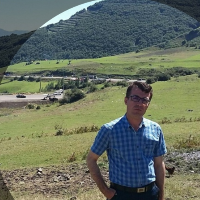Spatial analysis of surface water resources using water footprint approach in the Khiavchai sub-watersheds, Ardabil Province
This research aims to analyze the spatial water footprint of agricultural products in four categories of blue, green, gray, and white water in Khiavchai sub-watersheds. To this end, the meteorological data (monthly rainfall and temperature) were used as input data for the CROPWAT program. The Google Earth images were used to map the land use areas and estimate the area of agricultural and rangelands. It was found that apples, sour cherries, cherries, walnuts, and grapes are the dominant crops produced in the orchard area. The four types of virtual waters of agricultural products were analyzed in four land uses, i.e., orchards, rainfed agriculture, irrigated agriculture, and rangelands. The total water consumed by the apple product is more than other products in all sub-watersheds and the amount of virtual water of walnut is also high in most sub-watersheds. The total consumption of blue, green, white, and gray water in sour cherry, cherry, and grape was the same and was evaluated as less than the other two products. In addition, the average amount of blue water for rainfed agriculture was estimated as 2788.85 m3 t-1, among which lentils and chickpeas had the higher blue water among the rainfed crops. According to the results, sub-watersheds 7 and 14 located in western parts of the study area had the highest of virtual water. In sub-watershed 7, a large part of its area is used for rangeland and only a small part is related to rainfed agriculture, and all area of sub-watershed 14 is used for rangeland. Therefore, the appropriate cultivation pattern can be determined based on the amount of virtual water and its spatial changes.
-
Assessment and prioritization of the Water Security Index (WSI) in the Qarasu watershed sub-basins in Ardabil province
Fariba Esfandyari Darabad *, Behrouz Nezafat Takle,
Journal of Sustainable Urban and Regional Development Studies, Spring 2026 -
Analyzing the lateral changes of Aras River channel in Ardabil province using morphological indicators
Fariba Esfandyari Darabad, Sayyad Asghari Saraskanroud, Mehdi Ghandaiasl, *
Journal of Rs and Gis for natural Resources, Winter 2025 -
Determining the forest fire susceptibility map in the Astara city using the Analytical Hierarchy Process (AHP) and Frequency Ratio Model (FR)
*, Mohammad Golshan, Roghayeh Jahdi
Iranian Journal of Forest and Range Protection Research, -
Scenario-based land use management to restore natural areas and reducing soil erosion rate in a competing land uses condition
Khadijeh Haji, Abazar Esmali-Ouri *, ,, Habib Nazarnejad
Anthropogenic Pollution Journal, Summer and Autumn 2024 -
Estimation of temporal and spatial variations of flood and low flow indices extracted from the FDC in the Ardabil province rivers
Leyla Babaee, Nahideh Parchami, *
Journal of Spatial Analysis Environmental Hazarts, -
Ecological security index in the KoozehTopraghi Watershed, Ardabil Province
Raoof Mosrafazadeh, Layla Babaei, Nazila Alaie, Zeinab Hazbavi *
Environmental Researches,



